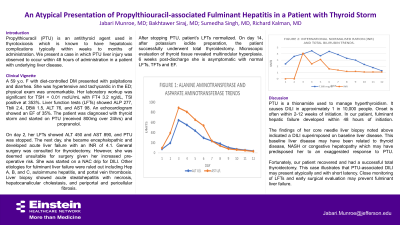Back


Poster Session E - Tuesday Afternoon
Category: Liver
E0534 - An Atypical Presentation of Propylthiouracil-Associated Fulminant Hepatitis in a Patient With Thyroid Storm
Tuesday, October 25, 2022
3:00 PM – 5:00 PM ET
Location: Crown Ballroom

Has Audio

Jabari Munroe, MD
Einstein Medical Center
Philadelphia, PA
Presenting Author(s)
Jabari Munroe, MD, Bakhtawer Siraj, MD, Sumedha Singh, MD, Richard Kalman, MD
Einstein Medical Center, Philadelphia, PA
Introduction: Propylthiouracil (PTU) is an antithyroid agent used in thyrotoxicosis which is known to have hepatotoxic complications typically within weeks to months of administration. We present a case in which PTU liver injury was observed to occur within 48 hours of administration in a patient with underlying liver disease.
Case Description/Methods: A 59 y.o. F with diet-controlled DM presented with palpitations and diarrhea. She was hypertensive and tachycardic in the ED; physical exam was unremarkable. Her laboratory workup was significant for TSH < 0.01 mcIU/mL with FT4 3.2 ng/dL, TSI positive at 353%. Liver function tests (LFTs) showed ALP 277, Tbili 2.4, DBili 1.5, ALT 76, and AST 98. An echocardiogram showed an EF of 35%. The patient was diagnosed with thyroid storm and started on PTU (received 800mg over 24hrs) and propranolol.
On day 2, her LFTs showed ALT 450 and AST 890, and PTU was stopped. The next day, she became encephalopathic and developed acute liver failure with an INR of 4.1. General surgery was consulted for thyroidectomy. However, she was deemed unsuitable for surgery given her increased pre-operative risk. She was started on a NAC drip for DILI. Other etiologies for fulminant liver failure were ruled out including Hep A, B, and C, autoimmune hepatitis, and portal vein thrombosis. Liver biopsy showed acute steatohepatitis with necrosis, hepatocanalicular cholestasis, and periportal and pericellular fibrosis.
After stopping PTU, patient’s LFTs normalized. On day 14, after potassium iodide preparation, the patient successfully underwent total thyroidectomy. Microscopic evaluation of thyroid tissue revealed multinodular hyperplasia. 6 weeks post-discharge she is asymptomatic with normal LFTs, TFTs and EF.
Discussion: PTU is a thionamide used to manage hyperthyroidism. It causes DILI in approximately 1 in 10,000 people. Onset is often within 2-12 weeks of initiation. In our patient, fulminant hepatic failure developed within 48 hours of initiation.
The findings of her core needle liver biopsy noted above indicated a DILI superimposed on baseline liver disease. This baseline liver disease may have been related to thyroid disease, NASH or congestive hepatopathy which may have predisposed her to an exaggerated response to PTU.
Fortunately, our patient recovered and had a successful total thyroidectomy. This case illustrates that PTU-associated DILI may present atypically and with short latency. Close monitoring of LFTs and early surgical evaluation may prevent fulminant liver failure.
Disclosures:
Jabari Munroe, MD, Bakhtawer Siraj, MD, Sumedha Singh, MD, Richard Kalman, MD. E0534 - An Atypical Presentation of Propylthiouracil-Associated Fulminant Hepatitis in a Patient With Thyroid Storm, ACG 2022 Annual Scientific Meeting Abstracts. Charlotte, NC: American College of Gastroenterology.
Einstein Medical Center, Philadelphia, PA
Introduction: Propylthiouracil (PTU) is an antithyroid agent used in thyrotoxicosis which is known to have hepatotoxic complications typically within weeks to months of administration. We present a case in which PTU liver injury was observed to occur within 48 hours of administration in a patient with underlying liver disease.
Case Description/Methods: A 59 y.o. F with diet-controlled DM presented with palpitations and diarrhea. She was hypertensive and tachycardic in the ED; physical exam was unremarkable. Her laboratory workup was significant for TSH < 0.01 mcIU/mL with FT4 3.2 ng/dL, TSI positive at 353%. Liver function tests (LFTs) showed ALP 277, Tbili 2.4, DBili 1.5, ALT 76, and AST 98. An echocardiogram showed an EF of 35%. The patient was diagnosed with thyroid storm and started on PTU (received 800mg over 24hrs) and propranolol.
On day 2, her LFTs showed ALT 450 and AST 890, and PTU was stopped. The next day, she became encephalopathic and developed acute liver failure with an INR of 4.1. General surgery was consulted for thyroidectomy. However, she was deemed unsuitable for surgery given her increased pre-operative risk. She was started on a NAC drip for DILI. Other etiologies for fulminant liver failure were ruled out including Hep A, B, and C, autoimmune hepatitis, and portal vein thrombosis. Liver biopsy showed acute steatohepatitis with necrosis, hepatocanalicular cholestasis, and periportal and pericellular fibrosis.
After stopping PTU, patient’s LFTs normalized. On day 14, after potassium iodide preparation, the patient successfully underwent total thyroidectomy. Microscopic evaluation of thyroid tissue revealed multinodular hyperplasia. 6 weeks post-discharge she is asymptomatic with normal LFTs, TFTs and EF.
Discussion: PTU is a thionamide used to manage hyperthyroidism. It causes DILI in approximately 1 in 10,000 people. Onset is often within 2-12 weeks of initiation. In our patient, fulminant hepatic failure developed within 48 hours of initiation.
The findings of her core needle liver biopsy noted above indicated a DILI superimposed on baseline liver disease. This baseline liver disease may have been related to thyroid disease, NASH or congestive hepatopathy which may have predisposed her to an exaggerated response to PTU.
Fortunately, our patient recovered and had a successful total thyroidectomy. This case illustrates that PTU-associated DILI may present atypically and with short latency. Close monitoring of LFTs and early surgical evaluation may prevent fulminant liver failure.
Disclosures:
Jabari Munroe indicated no relevant financial relationships.
Bakhtawer Siraj indicated no relevant financial relationships.
Sumedha Singh indicated no relevant financial relationships.
Richard Kalman indicated no relevant financial relationships.
Jabari Munroe, MD, Bakhtawer Siraj, MD, Sumedha Singh, MD, Richard Kalman, MD. E0534 - An Atypical Presentation of Propylthiouracil-Associated Fulminant Hepatitis in a Patient With Thyroid Storm, ACG 2022 Annual Scientific Meeting Abstracts. Charlotte, NC: American College of Gastroenterology.
